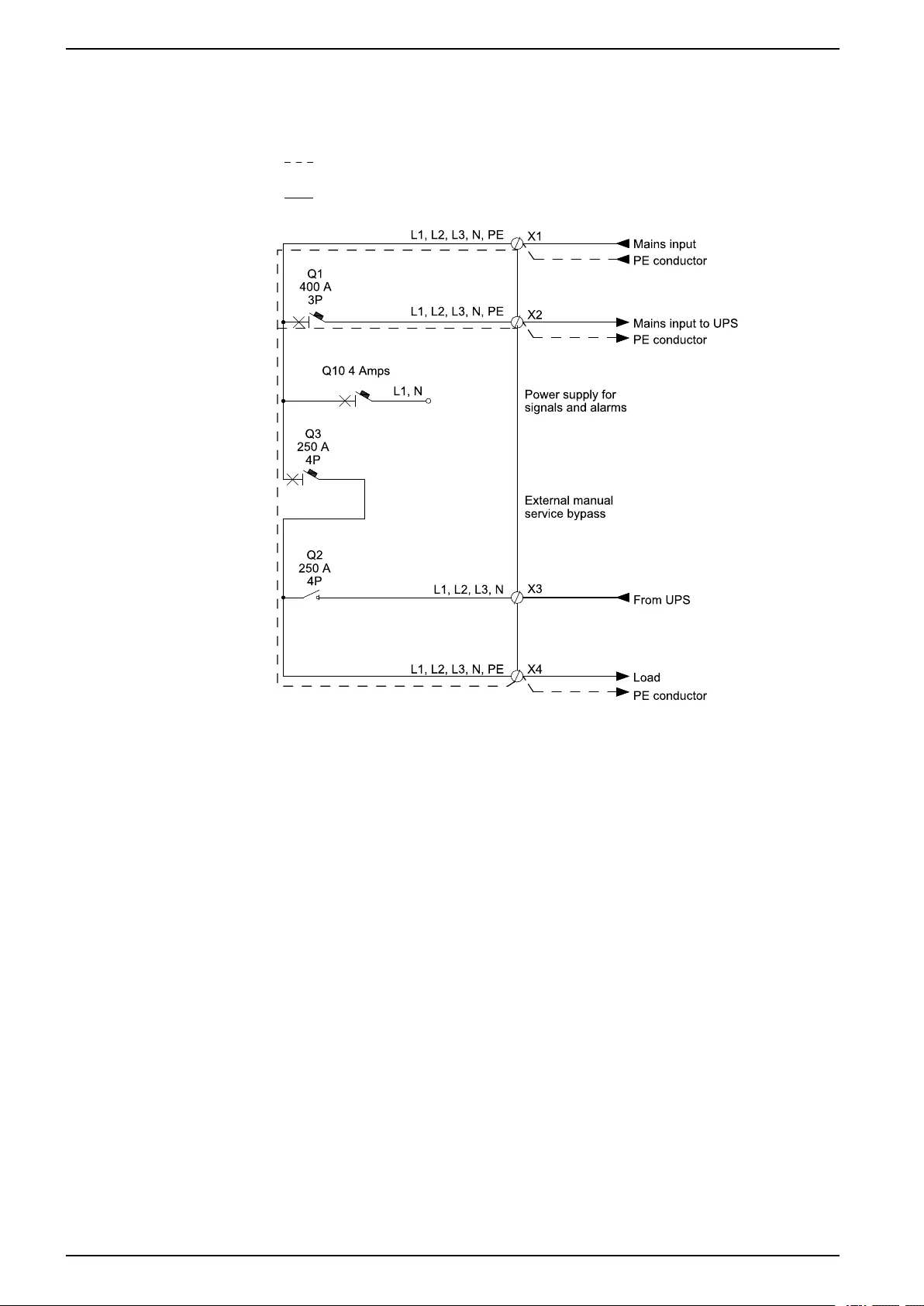Table of Contents
APC SYWMBP96K160H User Manual
Displayed below is the user manual for SYWMBP96K160H by APC which is a product in the Uninterruptible Power Supplies (UPSs) category. This manual has pages.
Related Manuals
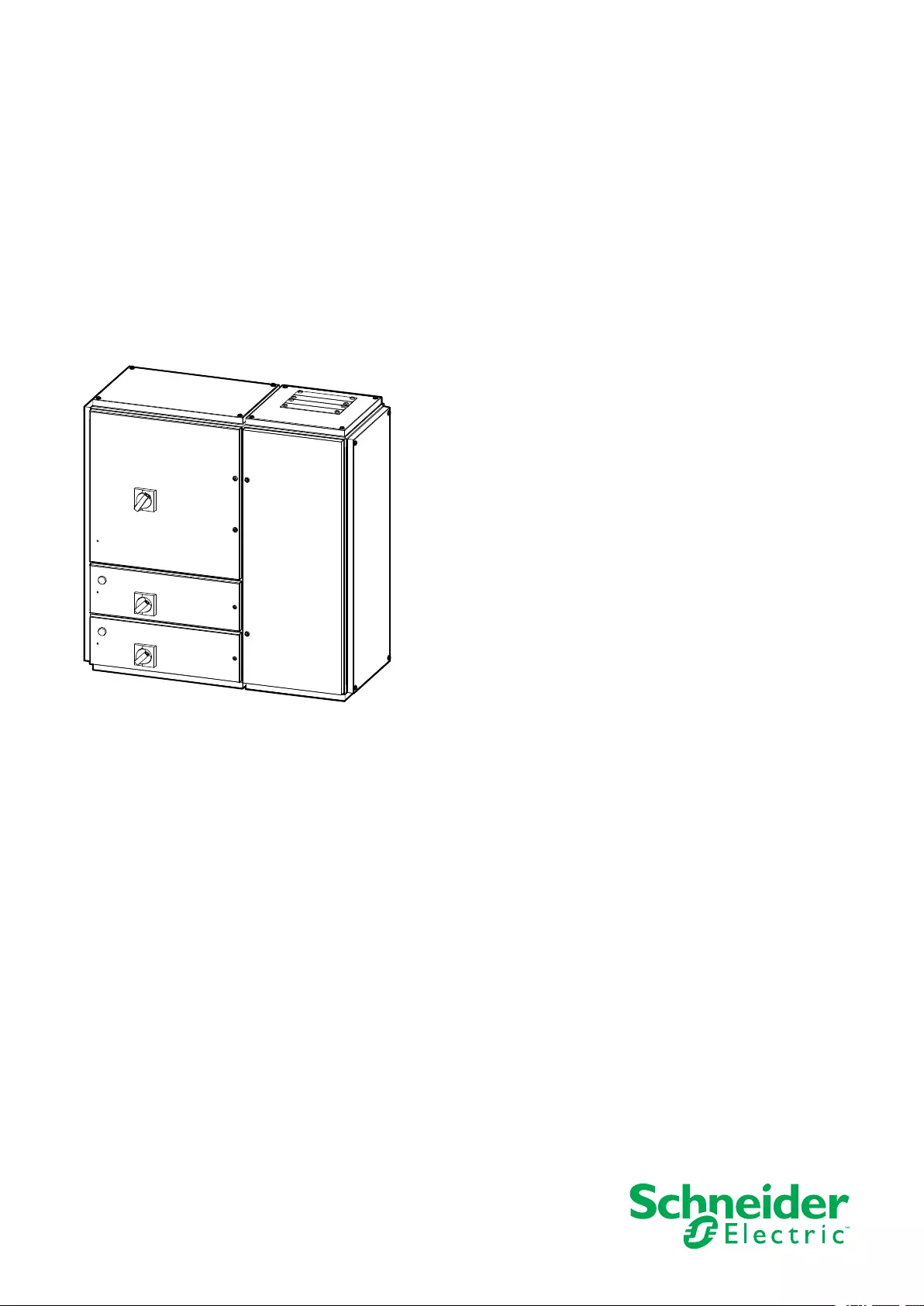
Symmetra™ PX
96/160 kW 400 V
Installation
Wall-Mounted Maintenance Bypass
SYWMBP96K160H
04/2015
www.schneider-electric.com

Legal Information
The Schneider Electric brand and any registered trademarks of Schneider Electric
Industries SAS referred to in this guide are the sole property of Schneider Electric
SA and its subsidiaries. They may not be used for any purpose without the owner's
permission, given in writing. This guide and its content are protected, within the
meaning of the French intellectual property code (Code de la propriété
intellectuelle français, referred to hereafter as "the Code"), under the laws of
copyright covering texts, drawings and models, as well as by trademark law. You
agree not to reproduce, other than for your own personal, noncommercial use as
defined in the Code, all or part of this guide on any medium whatsoever without
Schneider Electric's permission, given in writing. You also agree not to establish
any hypertext links to this guide or its content. Schneider Electric does not grant
any right or license for the personal and noncommercial use of the guide or its
content, except for a non-exclusive license to consult it on an "as is" basis, at your
own risk. All other rights are reserved.
Electrical equipment should be installed, operated, serviced, and maintained only
by qualified personnel. No responsibility is assumed by Schneider Electric for any
consequences arising out of the use of this material.
As standards, specifications, and designs change from time to time, please ask for
confirmation of the information given in this publication.

96/160 kW 400 V
Table of Contents
Important Safety Information.....................................................................5
Safety Precautions .....................................................................................6
Electrical Safety....................................................................................8
Product Specific Safety Information........................................................9
Specifications ............................................................................................10
Product Overview......................................................................................12
Site Planning..............................................................................................13
Space Requirements ................................................................................13
Prepare for Cables....................................................................................14
Mount the Maintenance Bypass Enclosure to the Wall.......................15
Connect the Power Cables......................................................................16
Connect the Communication Cables .....................................................17
One-line Diagram......................................................................................18
990–5251B–001 3

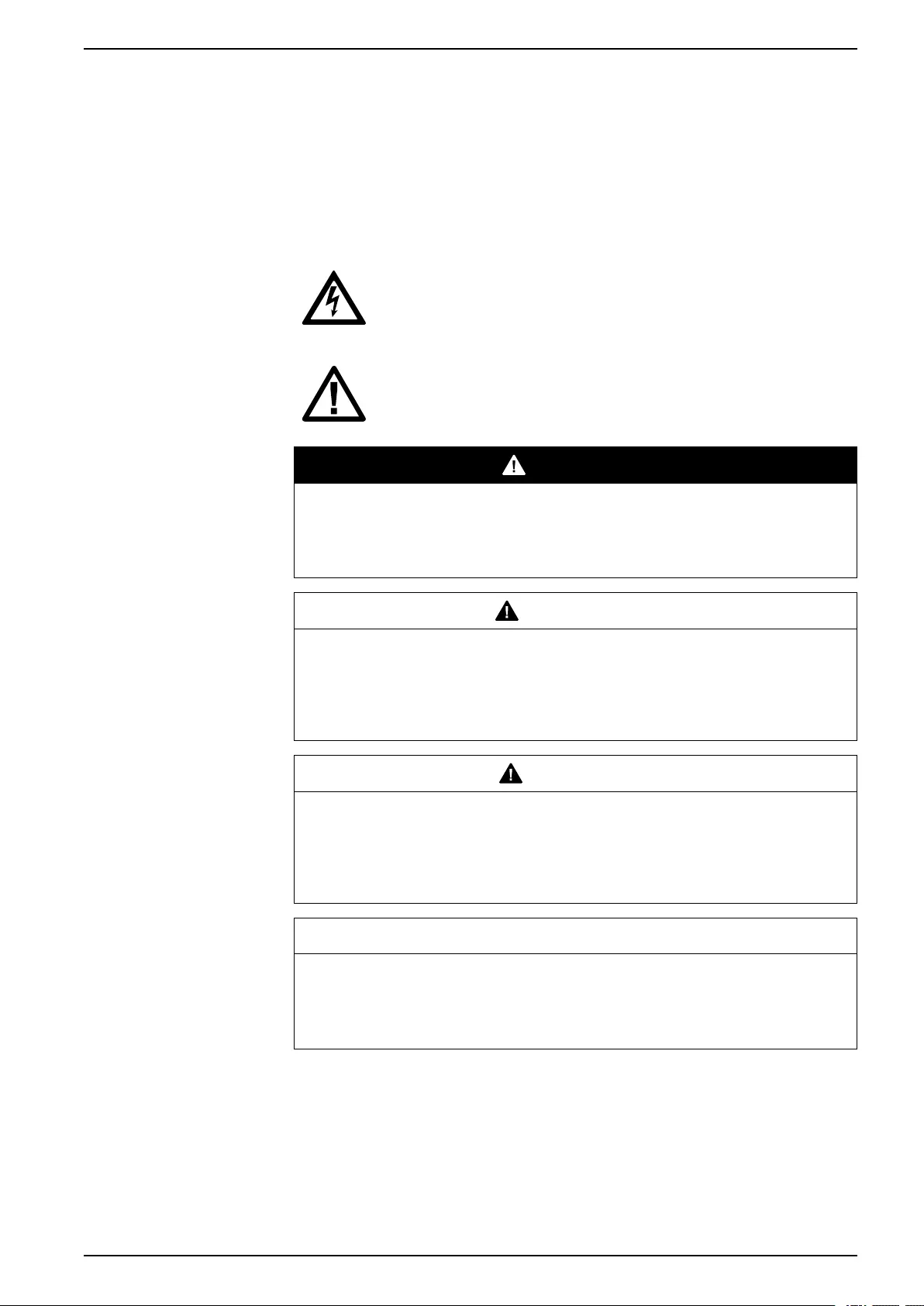
Important Safety Information 96/160 kW 400 V
Important Safety Information
Read these instructions carefully and look at the equipment to become familiar with
it before trying to install, operate, service or maintain it. The following safety
messages may appear throughout this manual or on the equipment to warn of
potential hazards or to call attention to information that clarifies or simplifies a
procedure.
The addition of this symbol to a “Danger” or “Warning” safety
message indicates that an electrical hazard exists which will result in
personal injury if the instructions are not followed.
This is the safety alert symbol. It is used to alert you to potential
personal injury hazards. Obey all safety messages with this symbol
to avoid possible injury or death.
DANGER
DANGER indicates a hazardous situation which, if not avoided, will result in
death or serious injury.
Failure to follow these instructions will result in death or serious injury.
WARNING
WARNING indicates a hazardous situation which, if not avoided, could result in
death or serious injury.
Failure to follow these instructions can result in death, serious injury, or
equipment damage.
CAUTION
CAUTION indicates a hazardous situation which, if not avoided, could result in
minor or moderate injury.
Failure to follow these instructions can result in injury or equipment
damage.
NOTICE
NOTICE is used to address practices not related to physical injury. The safety
alert symbol shall not be used with this type of safety message.
Failure to follow these instructions can result in equipment damage.
Please Note
Electrical equipment should only be installed, operated, serviced, and maintained
by qualified personnel. No responsibility is assumed by Schneider Electric for any
consequences arising out of the use of this material.
990–5251B–001 5
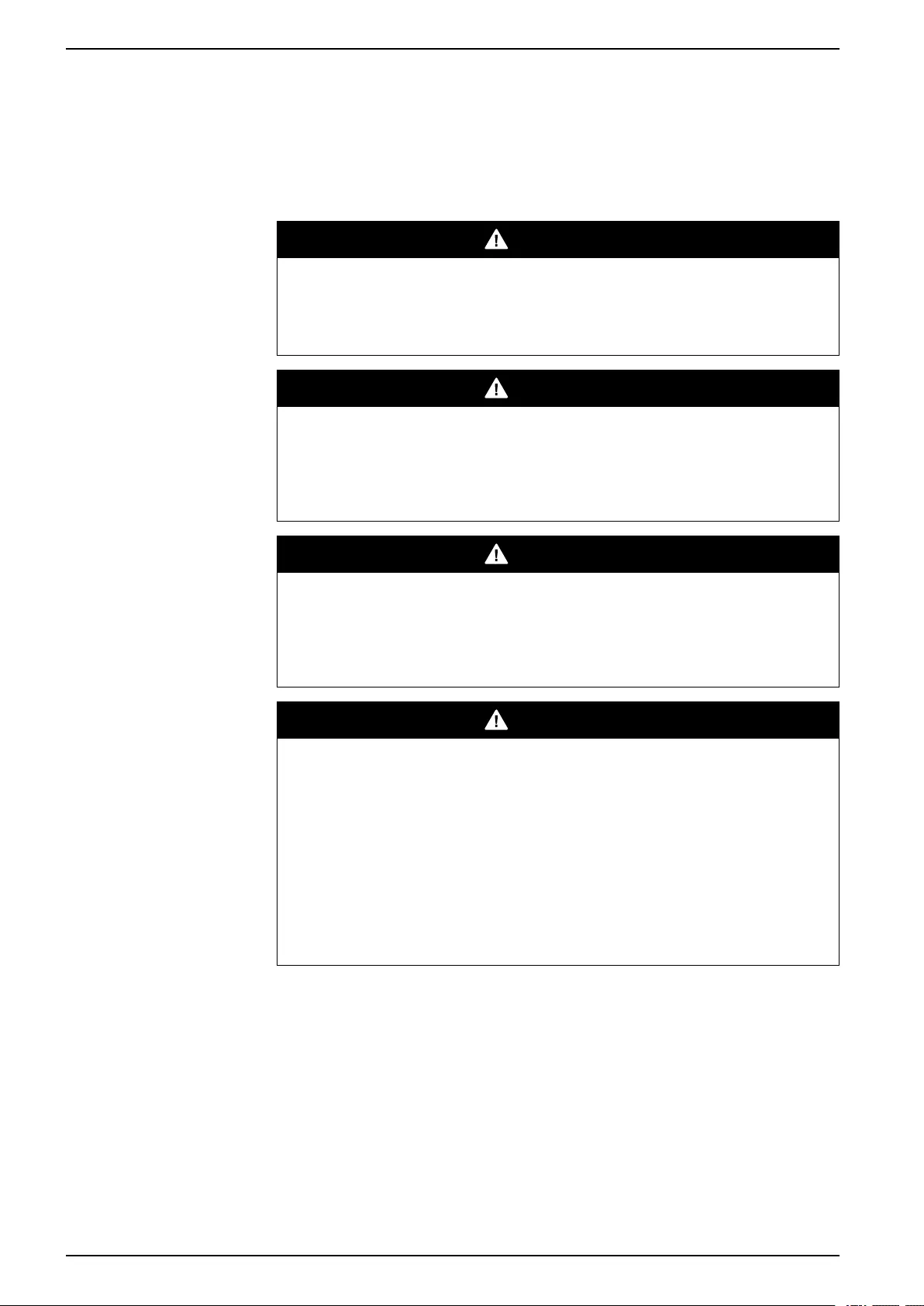
96/160 kW 400 V Important Safety Information
A qualified person is one who has skills and knowledge related to the construction,
installation, and operation of electrical equipment and has received safety training
to recognize and avoid the hazards involved.
Safety Precautions
DANGER
HAZARD OF ELECTRIC SHOCK, EXPLOSION, OR ARC FLASH
All safety instructions in this document must be read, understood and followed.
Failure to follow these instructions will result in death or serious injury.
DANGER
HAZARD OF ELECTRIC SHOCK, EXPLOSION, OR ARC FLASH
Read all instructions in the Installation Manual before installing or working on this
UPS system.
Failure to follow these instructions will result in death or serious injury.
DANGER
HAZARD OF ELECTRIC SHOCK, EXPLOSION OR ARC FLASH
Do not install the UPS system until all construction work has been completed
and the installation room has been cleaned.
Failure to follow these instructions will result in death or serious injury.
DANGER
HAZARD OF ELECTRIC SHOCK, EXPLOSION, OR ARC FLASH
• The product must be installed according to the specifications and
requirements as defined by Schneider Electric. It concerns in particular the
external and internal protections (upstream breakers, battery breakers,
cabling, etc.) and environmental requirements. No responsibility is assumed
by Schneider Electric if these requirements are not respected.
• After the UPS system has been electrically wired, do not start up the system.
Startup must only be performed by Schneider Electric.
Failure to follow these instructions will result in death or serious injury.
6 990–5251B–001

Important Safety Information 96/160 kW 400 V
DANGER
HAZARD OF ELECTRIC SHOCK, EXPLOSION, OR ARC FLASH
The UPS System must be installed according to local and national regulations.
Install the UPS according to:
• IEC 60364 (including 60364–4–41- protection against electric shock, 60364–
4–42 - protection against thermal effect, and 60364–4–43 - protection against
overcurrent), or
• NEC NFPA 70, or
• Canadian Electrical Code (C22.1, Part 1)
depending on which one of the standards apply in your local area.
Failure to follow these instructions will result in death or serious injury.
DANGER
HAZARD OF ELECTRIC SHOCK, EXPLOSION OR ARC FLASH
• Install the UPS system in a temperature controlled environment free of
conductive contaminants and humidity.
• Install the UPS system on a non-inflammable, level and solid surface (e.g.
concrete) that can support the weight of the system.
Failure to follow these instructions will result in death or serious injury.
DANGER
HAZARD OF ELECTRIC SHOCK, EXPLOSION OR ARC FLASH
The UPS is not designed for and must therefore not be installed in the following
unusual operating environments:
• Damaging fumes
• Explosive mixtures of dust or gases, corrosive gases, or conductive or radiant
heat from other sources
• Moisture, abrasive dust, steam or in an excessively damp environment
• Fungus, insects, vermin
• Salt-laden air or contaminated cooling refrigerant
• Pollution degree higher than 2 according to IEC 60664-1
• Exposure to abnormal vibrations, shocks, and tilting
• Exposure to direct sunlight, heat sources, or strong electromagnetic fields
Failure to follow these instructions will result in death or serious injury.
DANGER
HAZARD OF ELECTRIC SHOCK, EXPLOSION, OR ARC FLASH
Do not drill/punch holes for cables or conduits with the gland plates installed and
do not drill/punch in close proximity to the UPS.
Failure to follow these instructions will result in death or serious injury.
990–5251B–001 7
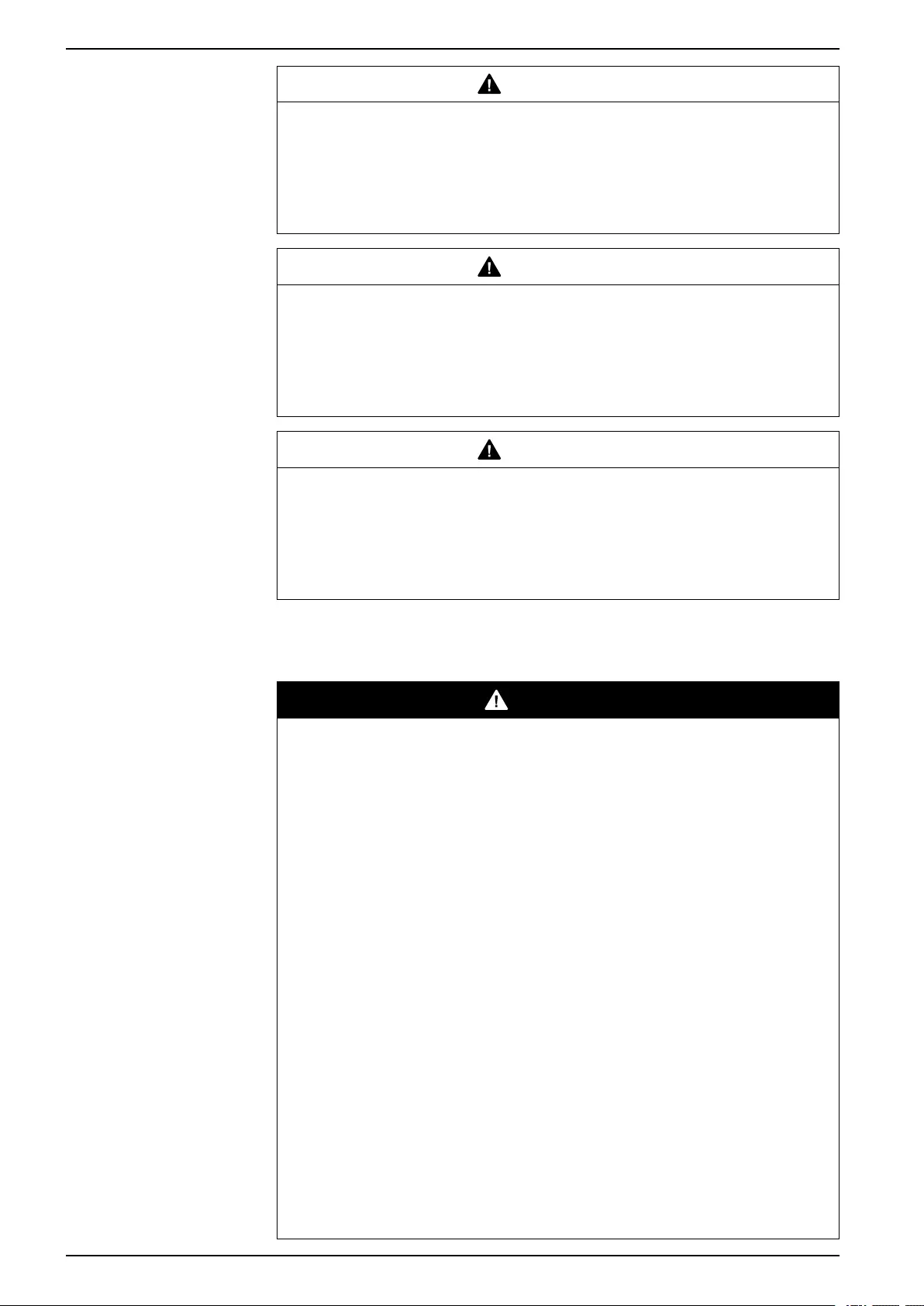
96/160 kW 400 V Important Safety Information
WARNING
HAZARD OF ARC FLASH
Do not make mechanical changes to the product (including removal of cabinet
parts or drilling/cutting of holes) that are not described in the Installation Manual.
Failure to follow these instructions can result in death, serious injury, or
equipment damage.
WARNING
HAZARD OF OVERHEATING
Respect the space requirements around the UPS system and do not cover the
product’s ventilation openings when the UPS system is in operation.
Failure to follow these instructions can result in death, serious injury, or
equipment damage.
WARNING
HAZARD OF EQUIPMENT DAMAGE
Do not connect the UPS output to regenerative load systems including
photovoltaic systems and speed drives.
Failure to follow these instructions can result in death, serious injury, or
equipment damage.
Electrical Safety
DANGER
HAZARD OF ELECTRIC SHOCK, EXPLOSION OR ARC FLASH
• Electrical equipment must be installed, operated, serviced, and maintained
only by qualified personnel.
• The UPS system must be installed in a room with restricted access (qualified
personnel only).
• Apply appropriate personal protective equipment (PPE) and follow safe
electrical work practices.
• Turn off all power supplying the UPS system before working on or inside the
equipment.
• Before working on the UPS system, check for hazardous voltage between all
terminals including the protective earth.
• The UPS contains an internal energy source. Hazardous voltage can be
present even when disconnected from the utility/mains supply. Before
installing or servicing the UPS system, ensure that the units are OFF and that
utility/mains and batteries are disconnected. Wait five minutes before
opening the UPS to allow the capacitors to discharge.
• A disconnection device (e.g. disconnection circuit breaker or switch) must be
installed to enable isolation of the system from upstream power sources in
accordance with local regulations. This disconnection device must be easily
accessible and visible.
• The UPS must be properly earthed/grounded and due to a high leakage
current, the earthing/grounding conductor must be connected first.
Failure to follow these instructions will result in death or serious injury.
8 990–5251B–001
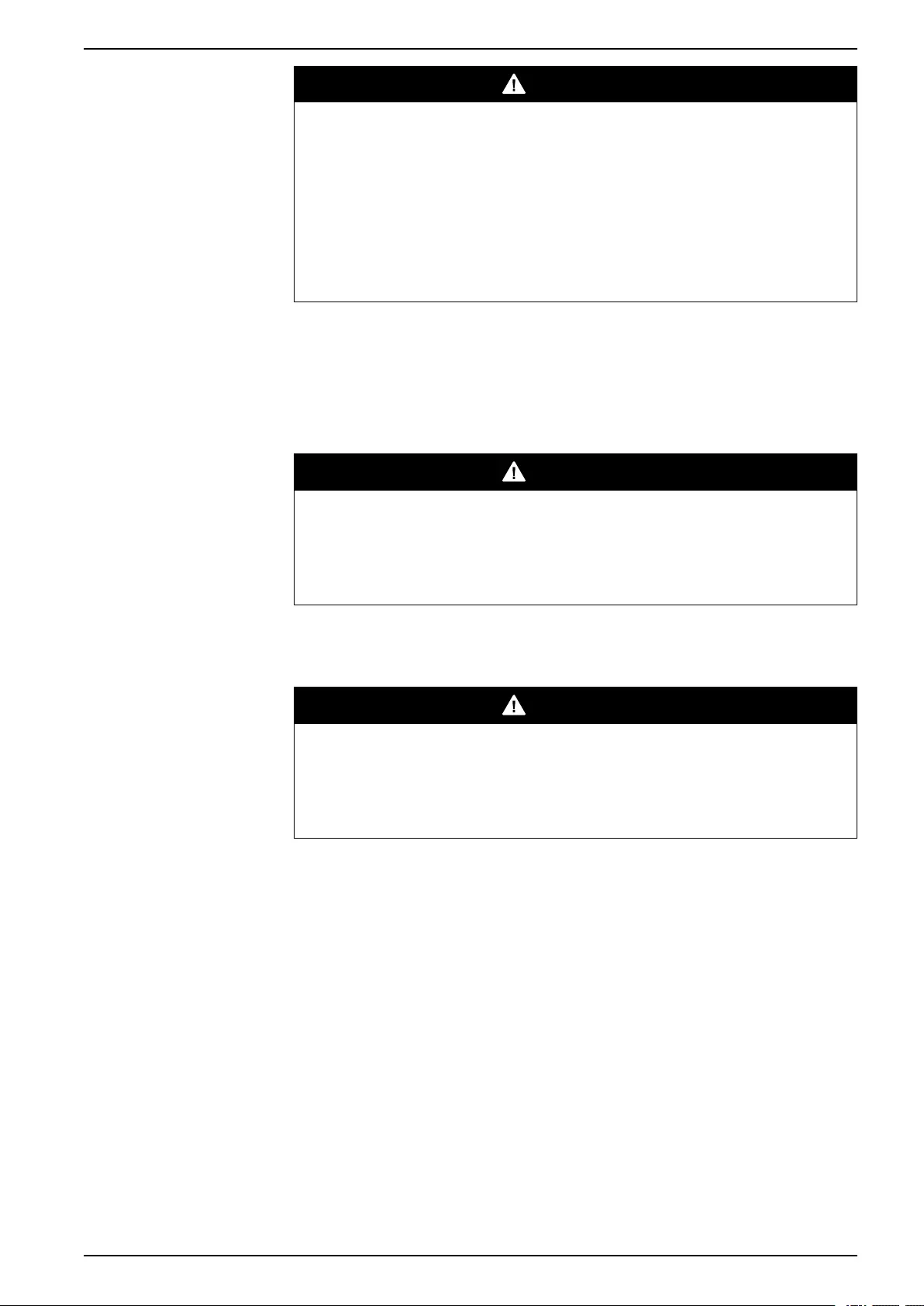
Important Safety Information 96/160 kW 400 V
DANGER
HAZARD OF ELECTRIC SHOCK, EXPLOSION, OR ARC FLASH
In systems where backfeed protection is not part of the standard design, an
automatic isolation device (backfeed protection option or other device meeting
the requirements of IEC/EN 62040–1 or UL1778 4th Edition – depending on
which of the two standards apply to your local area) must be installed to prevent
hazardous voltage or energy at the input terminals of the isolation device. The
device must open within 15 seconds after the upstream power supply fails and
must be rated according to the specifications.
Failure to follow these instructions will result in death or serious injury.
When the UPS input is connected through external isolators that, when opened,
isolate the neutral or when the automatic backfeed isolation is provided external to
the equipment or is connected to an IT power distribution system, a label must be
fitted at the UPS input terminals, and on all primary power isolators installed
remote from the UPS area and on external access points between such isolators
and the UPS, by the user, displaying the following text (or equivalent in a language
which is acceptable in the country in which the UPS system is installed):
DANGER
HAZARD OF ELECTRIC SHOCK, EXPLOSION, OR ARC FLASH
Risk of Voltage Backfeed. Before working on this circuit: Isolate the UPS and
check for hazardous voltage between all terminals including the protective earth.
Failure to follow these instructions will result in death or serious injury.
Product Specific Safety Information
DANGER
HAZARD OF ELECTRICAL SHOCK, EXPLOSION OR ARC FLASH
Use a forklift or other lifting device to lift the maintenance bypass enclosure to
the installation height.
Failure to follow these instructions will result in death or serious injury.
990–5251B–001 9

96/160 kW 400 V Specifications
Specifications
Electrical
Nominal input voltage (V) 400
Nominal bypass input voltage (V) 400
Nominal output voltage (V) 400
Frequency (Hz) 50
Earthing TN-S
Maximum rated input current (A) 400
Maximum rated output current (A) 250
Maximum short-circuit withstand (kA) 30, 0.1 sec
Switch and Breaker Sizes
Mains input breaker Q1 (A) 400
UPS output switch Q2 (A) 250
Maintenance bypass breaker Q3 (A) 250
Minimum Settings for Q1 Breaker
UPS Rating Io Ir (x10) Isd (x lr)
96 kW 160 A 1 10
160 kW 320 A 1 10
Recommended Cable Sizes
NOTE: Recommended cable sizes are for installation methods B1, B2, C in
EN60364–5–52 table 52–E3.
NOTE: Use only copper conductors with a minimum rating for 70 °C.
96 kW 160 kW Maximum allowed
by terminals
Mains input (L1, L2, L3, N, PE) 95 (mm2) 240 (mm2) 2/240 (mm2)
Bypass input (L1, L2, L3, N, PE) 70 (mm2) 150 (mm2) 185 (mm2)
System output (L1, L2, L3, N, PE) 70 (mm2) 150 (mm2) 185 (mm2)
10 990–5251B–001

Specifications 96/160 kW 400 V
Weights and Dimensions
Weight (kg) Height (mm) Width (mm) Depth (mm)
Without packaging 115 1010 1010 400
With packaging 120 1300 1200 800
Environmental
Environment Indoor use only, protect from water and conductive contaminants
Temperature –5 °C to + 40 °C
Humidity 0 to 95%, non-condensing
Pollution degree (IEC60439–01) 1
Protection class IP31
Torque
Mains input terminal block (Nm) 31
Mains input to UPS terminal block (Nm) 31
UPS output terminal block (Nm) 26
System output terminal block (Nm) 31
990–5251B–001 11
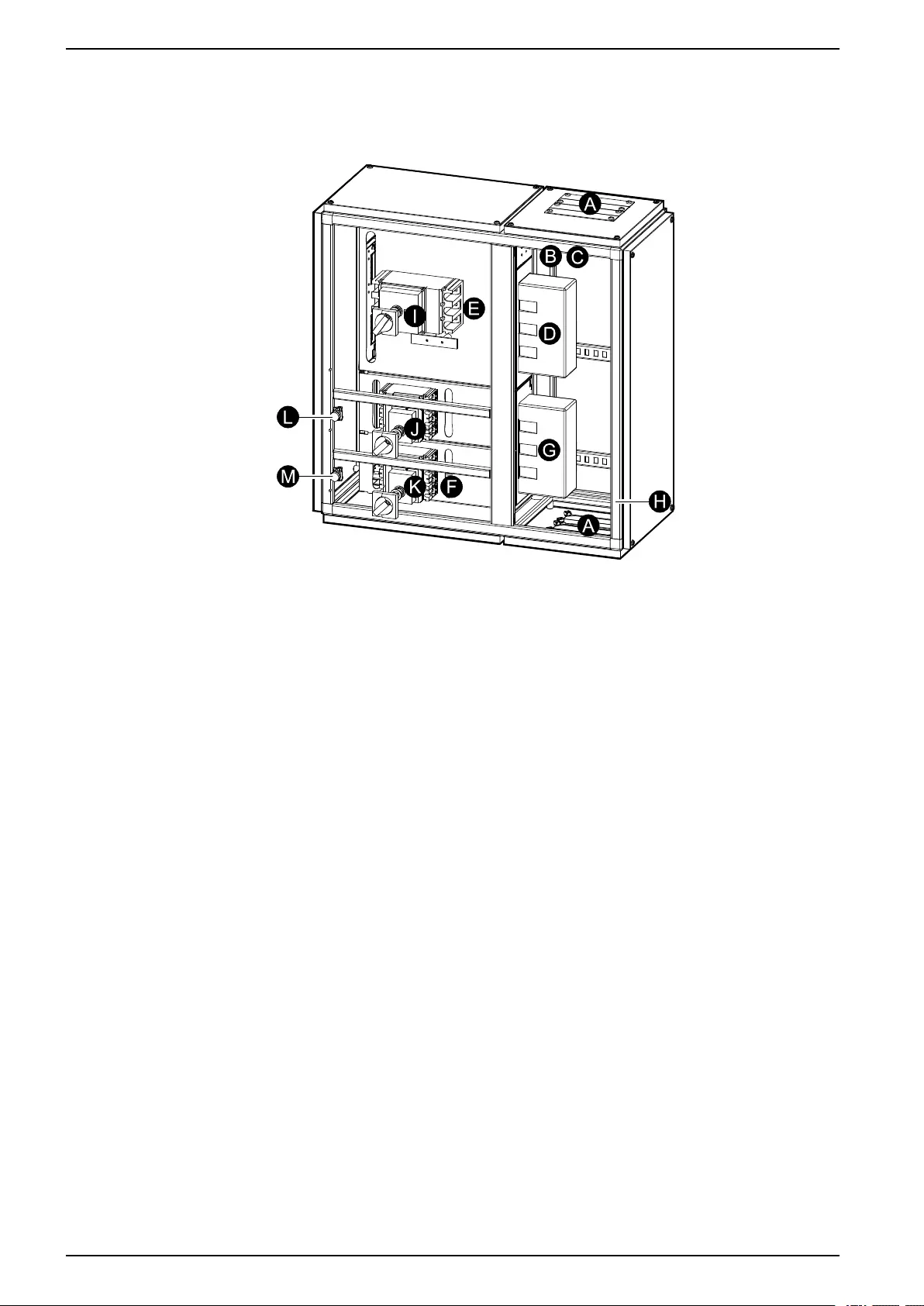
96/160 kW 400 V Product Overview
Product Overview
Front View (Interior)
A. Cable entry
B. Q10 power supply for signals and alarms
C. Communication terminal block
D. Mains input terminal block
E. Terminals for UPS input
F. Terminals for UPS output
G. System output terminal block
H. PE/Ground
I. Mains input breaker Q1
J. Maintenance bypass breaker Q3
K. UPS output switch Q2
L. LED H3
M. LED H2
12 990–5251B–001
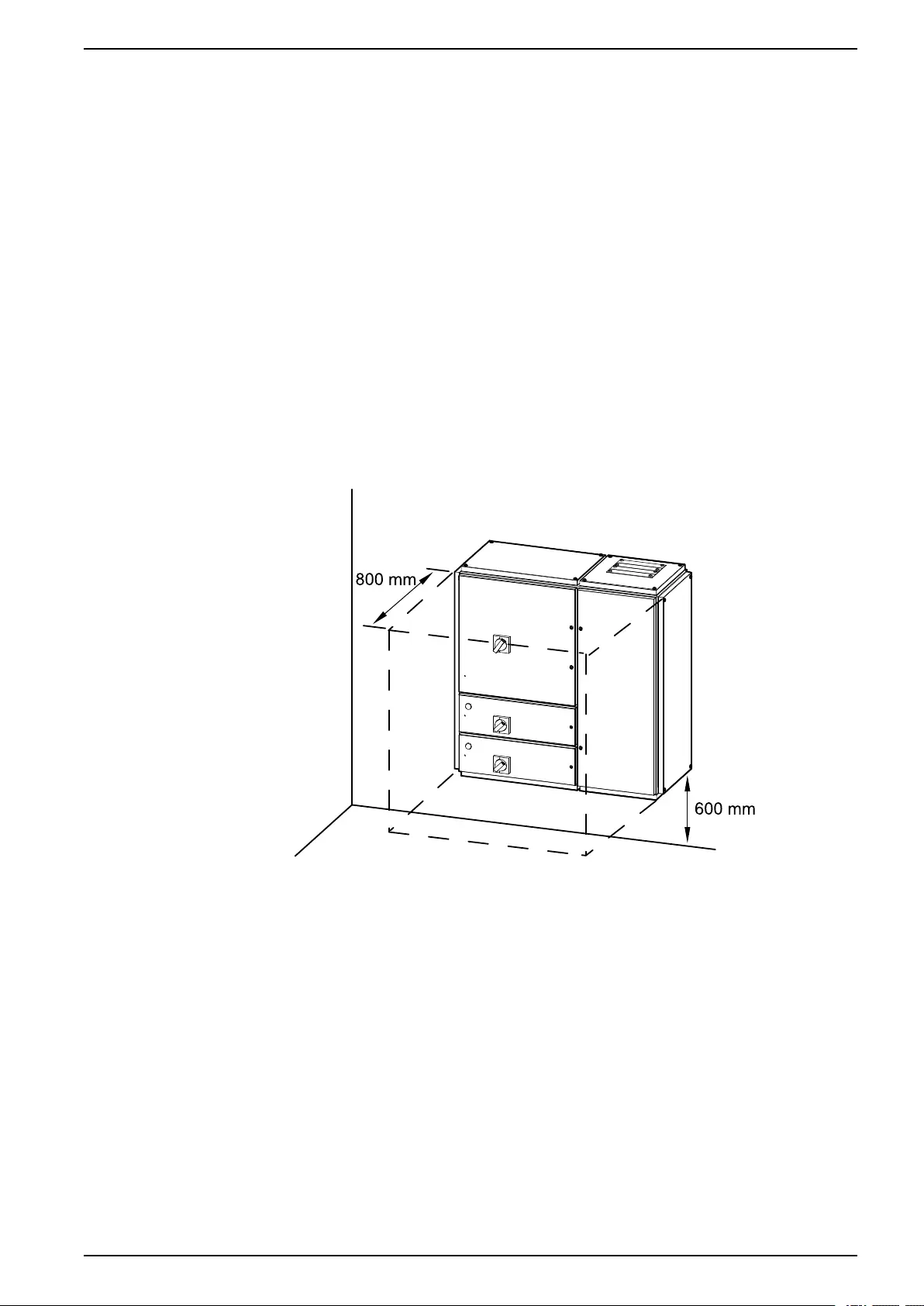
Site Planning 96/160 kW 400 V
Site Planning
NOTE: When selecting a location for the maintenance bypass enclosure, consider
the need for easy access to all switches and internal components.
NOTE: Ensure that the selected wall is structurally sound and able to support the
size and weight of the unit.
NOTE: Protect the maintenance bypass enclosure at all times from excessive
moisture, construction dirt, corrosive elements, or other contaminants.
Space Requirements
Refer to the below figure to determine the space requirements for the maintenance
bypass enclosure. Consult local codes for any additional requirements. Ideally,
install the maintenance bypass enclosure in a location close to the UPS. When
door or cable access areas are open, an IP rating of IP2XC must be used.
Front view
990–5251B–001 13
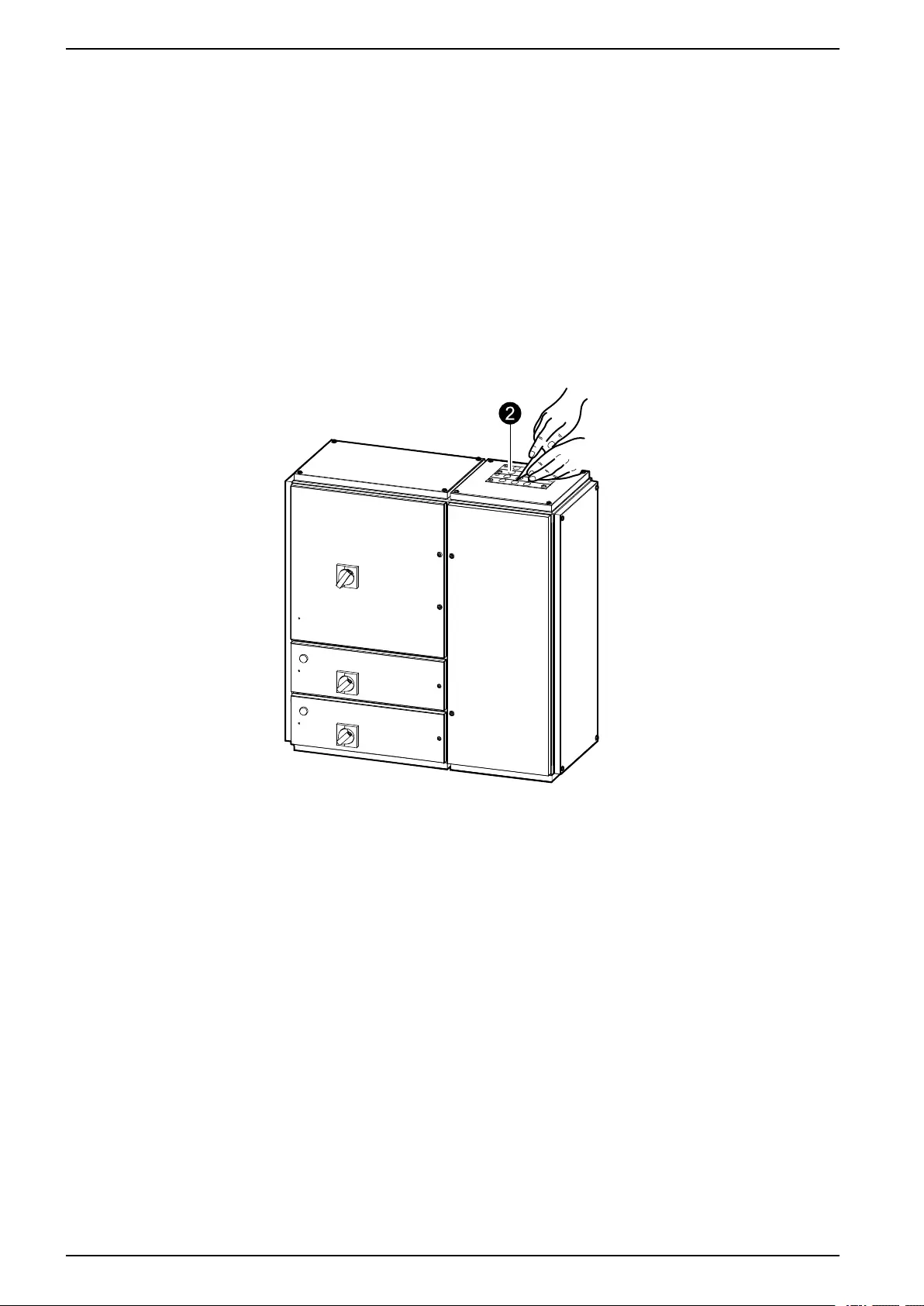
96/160 kW 400 V Prepare for Cables
Prepare for Cables
NOTE: All power cables must be connected on site. External power cables are not
supplied with the maintenance bypass enclosure.
NOTE: You can cut holes for cable access either before or after you have mounted
the maintenance bypass enclosure to the wall. Schneider Electric recommends
that you create all necessary holes before mounting the maintenance bypass
enclosure.
NOTE: The gland plate with small holes can be replaced by the bottom plate if
necessary. To maintain ingress level a gland plate must be installed in each
opening.
Front view
1. Open the left front door.
2. Use a knife to cut an x in either the top or bottom gland plate of the
maintenance bypass enclosure.
14 990–5251B–001
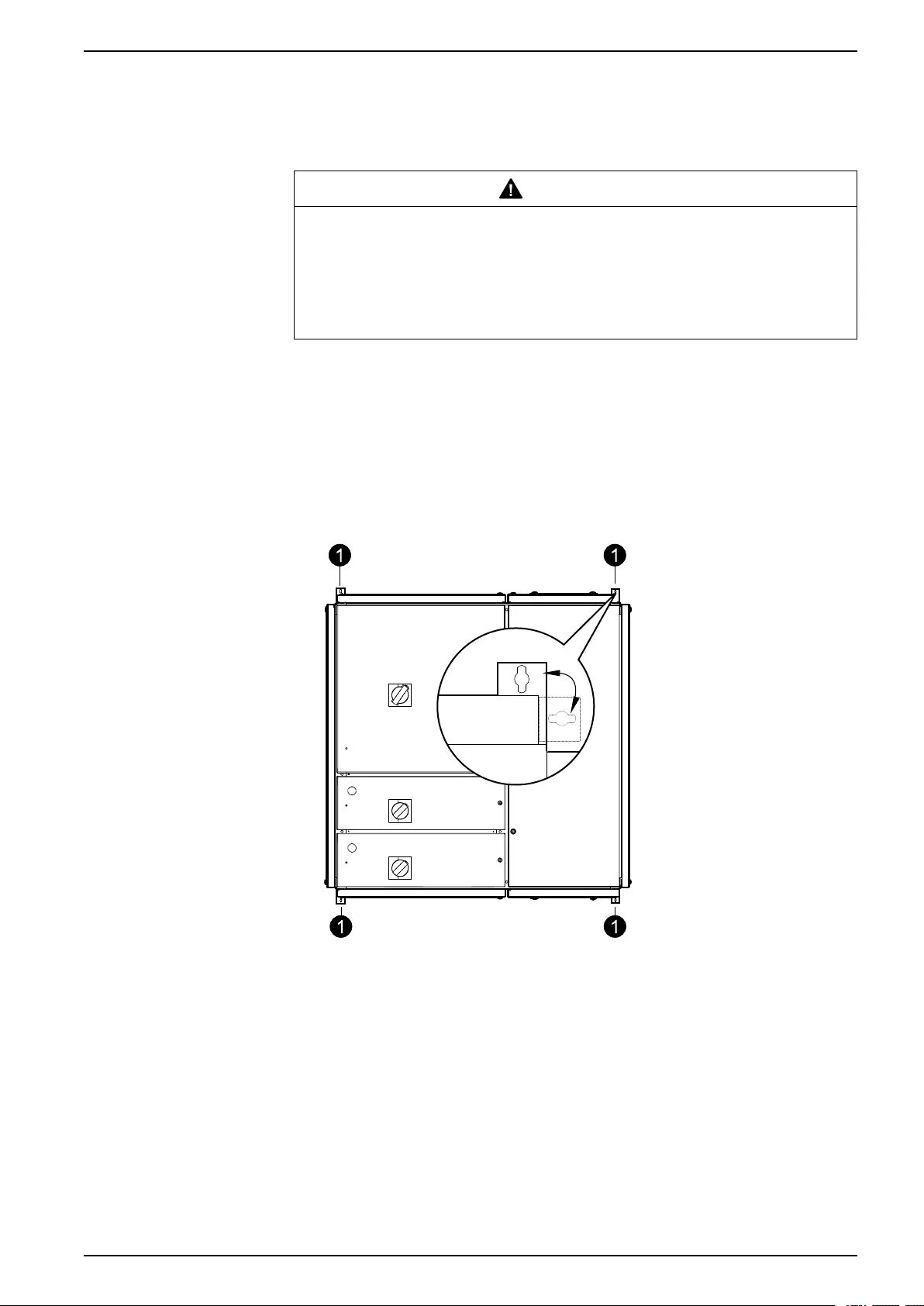
Mount the Maintenance Bypass
Enclosure to the Wall 96/160 kW 400 V
Mount the Maintenance Bypass Enclosure
to the Wall
CAUTION
HAZARD OF INJURY
Anchoring bolts are not supplied. Use anchors/bolts that are suitable to support
the weight of the maintenance bypass enclosure.
Failure to follow these instructions can result in injury or equipment
damage.
1. Measure and mark the four mounting hole locations on the wall.
2. Drill holes in each of the four marked locations and mount anchor bolts.
3. Lift the maintenance bypass enclosure, position it against the backing and line it
up with the four holes/anchor bolts. Secure the maintenance bypass enclosure
with the four bolts and flat washers.
Front view
990–5251B–001 15
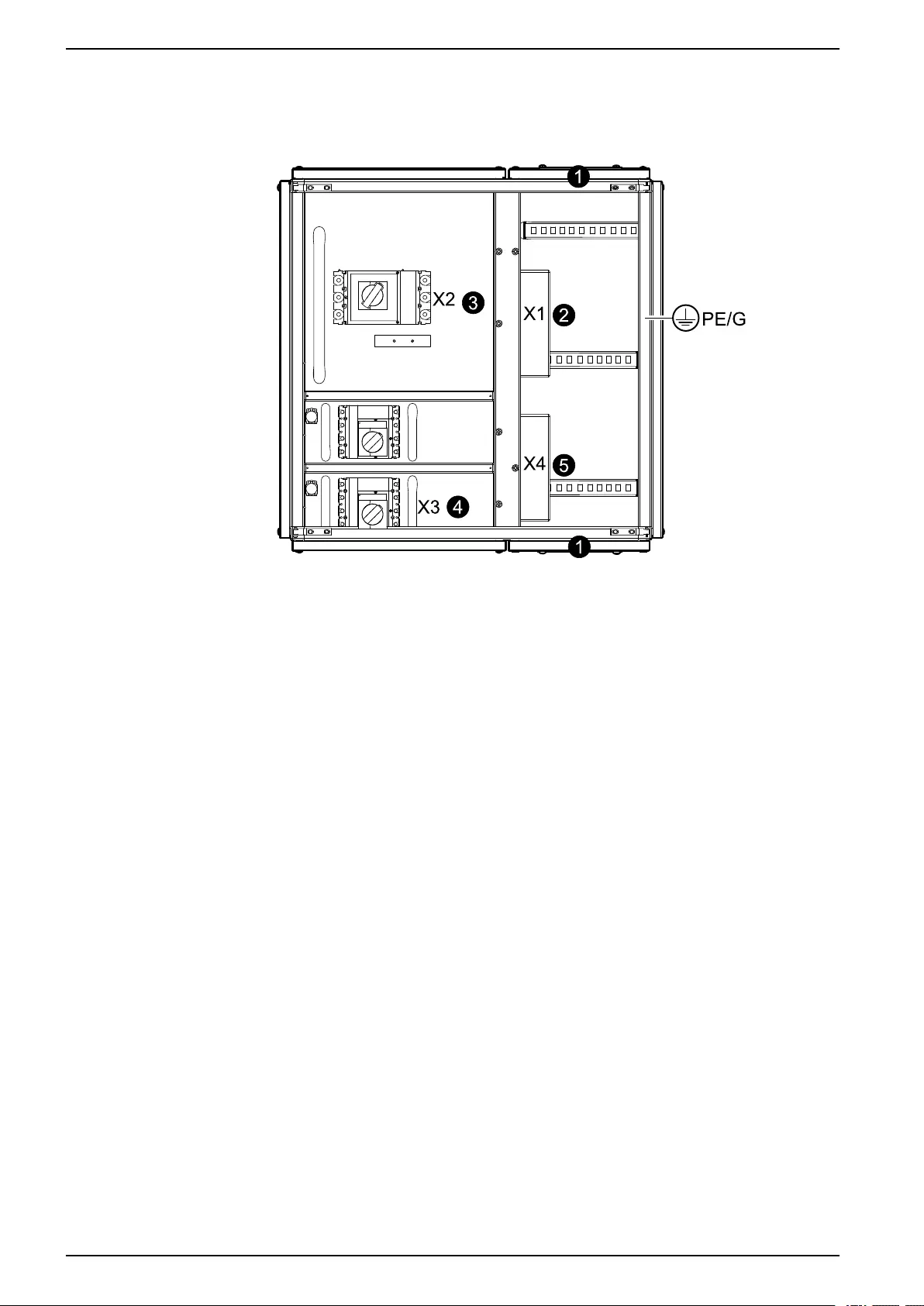
96/160 kW 400 V Connect the Power Cables
Connect the Power Cables
Front view
1. Route the cables through the top or bottom of the maintenance bypass
enclosure.
2. Connect the mains input cables (L1, L2, L3, N) to the terminal block X1 and the
PE cable to the PE/G bar.
3. Connect the input cables from the UPS (L1, L2, L3, N) to the Q1 breaker
terminals X2 and the PE cable to the PE/G bar.
4. Connect the output cables from the UPS (L1, L2, L3, N) to the Q2 breaker
terminals X3.
5. Connect the system output cables (L1, L2, L3, N, PE) to the terminal block X4
and the PE cable to the PE/G bar.
16 990–5251B–001
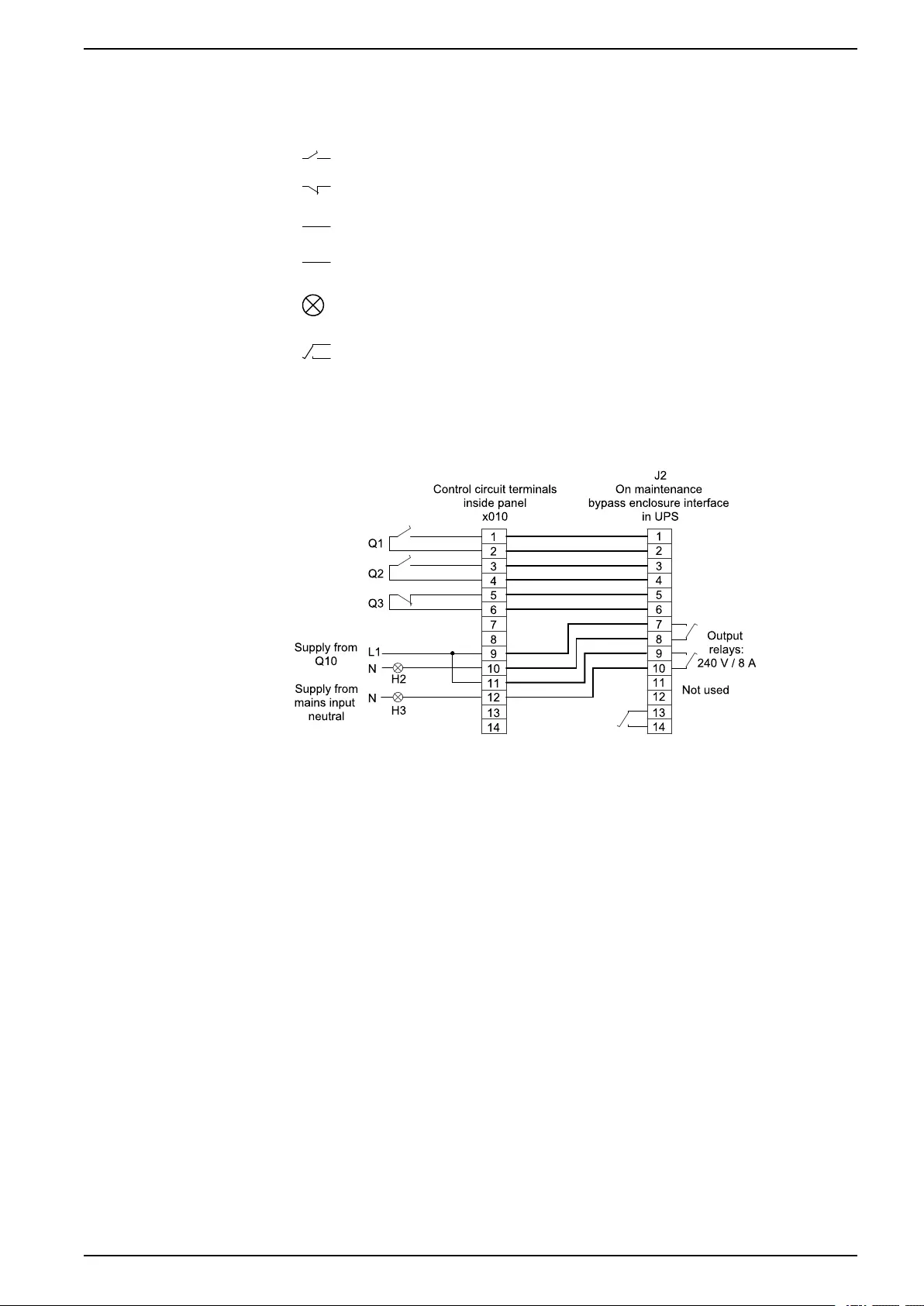
Connect the Communication Cables 96/160 kW 400 V
Connect the Communication Cables
Auxiliary contact N/O
Auxiliary contact N/C
Cables provided by others
Cables provided by vendor
230/240 VAC green LED
Open to indicate external bypass present
NOTE: For third party switchgear without surveillance, remove the jumper pin
between J2 pins 13 and 14. For wall-mounted switchgear with surveillance
interconnected to the maintenance bypass interface board, leave the jumper pin
installed between J2 pins 13 and 14.
• Control cabling must be labelled at all connection points.
• Cables should be terminated with insulated ferrules or crimps.
• LEDs H2 and H3 must be located on respective panel doors.
• H2 and H3 must be terminated with insulated spade crimps.
• H2 and H3 must be 230/240 VAC green LEDs.
• Auxiliary NO contacts on Q1 and Q2 are late make with respect to the main
poles of Q1 and Q2.
• Auxiliary NC contacts on Q3 is an early break with respect to the main poles of
Q3.
990–5251B–001 17


Schneider Electric
35 rue Joseph Monier
92500 Rueil Malmaison
France
+ 33 (0) 1 41 29 70 00
www.schneider-electric.com
As standards, specifications, and design change from time to time,
please ask for confirmation of the information given in this publication.
© 2012 – 2015 Schneider Electric. All rights reserved.
990–5251B–001
